An Analysis of Food Quality Issues in Australian Hospitals: A Report
VerifiedAdded on 2022/10/14
|7
|1490
|352
Report
AI Summary
This report examines the legal and ethical perspectives of food quality in Australian hospitals, particularly focusing on patient care and nutrition. It begins with a case study of complaints about food quality at the Repatriation General Hospital in DAW Park, highlighting issues such as dry, tasteless fish and rice, and frozen potato chips. The report emphasizes the importance of adhering to food safety standards and nutritional guidelines, referencing guidelines from NHS England and other Australian health authorities. It discusses the vulnerability of patients and the potential health risks associated with substandard food, including the role of suppliers like Celsus. The report suggests implementing food safety and quality management software to monitor and improve food quality. The conclusion underscores the significance of such systems in maintaining quality control and ensuring patient well-being, with a focus on holistic solutions to address the identified problems.

Paraphrase This Document
Need a fresh take? Get an instant paraphrase of this document with our AI Paraphraser
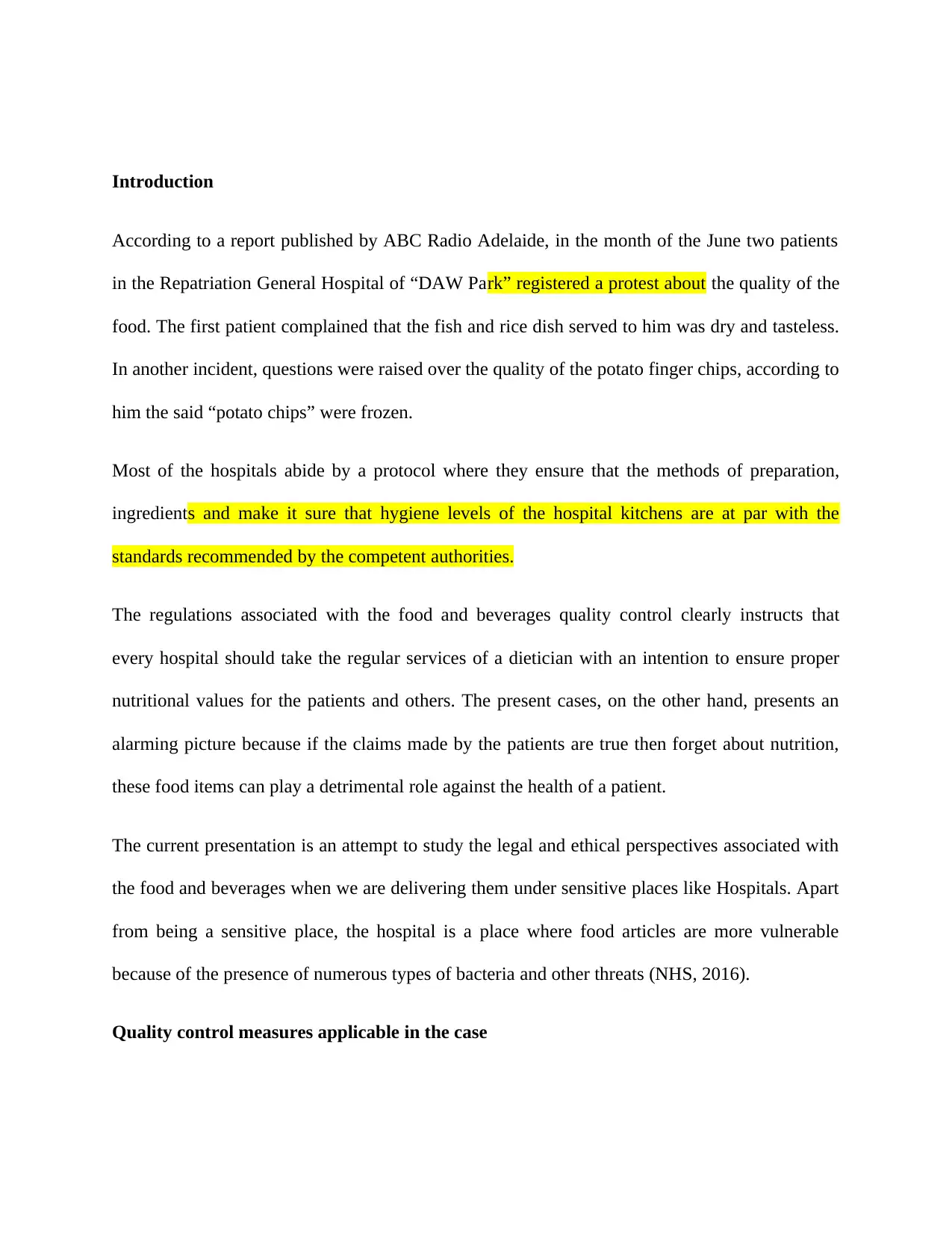
Introduction
According to a report published by ABC Radio Adelaide, in the month of the June two patients
in the Repatriation General Hospital of “DAW Park” registered a protest about the quality of the
food. The first patient complained that the fish and rice dish served to him was dry and tasteless.
In another incident, questions were raised over the quality of the potato finger chips, according to
him the said “potato chips” were frozen.
Most of the hospitals abide by a protocol where they ensure that the methods of preparation,
ingredients and make it sure that hygiene levels of the hospital kitchens are at par with the
standards recommended by the competent authorities.
The regulations associated with the food and beverages quality control clearly instructs that
every hospital should take the regular services of a dietician with an intention to ensure proper
nutritional values for the patients and others. The present cases, on the other hand, presents an
alarming picture because if the claims made by the patients are true then forget about nutrition,
these food items can play a detrimental role against the health of a patient.
The current presentation is an attempt to study the legal and ethical perspectives associated with
the food and beverages when we are delivering them under sensitive places like Hospitals. Apart
from being a sensitive place, the hospital is a place where food articles are more vulnerable
because of the presence of numerous types of bacteria and other threats (NHS, 2016).
Quality control measures applicable in the case
According to a report published by ABC Radio Adelaide, in the month of the June two patients
in the Repatriation General Hospital of “DAW Park” registered a protest about the quality of the
food. The first patient complained that the fish and rice dish served to him was dry and tasteless.
In another incident, questions were raised over the quality of the potato finger chips, according to
him the said “potato chips” were frozen.
Most of the hospitals abide by a protocol where they ensure that the methods of preparation,
ingredients and make it sure that hygiene levels of the hospital kitchens are at par with the
standards recommended by the competent authorities.
The regulations associated with the food and beverages quality control clearly instructs that
every hospital should take the regular services of a dietician with an intention to ensure proper
nutritional values for the patients and others. The present cases, on the other hand, presents an
alarming picture because if the claims made by the patients are true then forget about nutrition,
these food items can play a detrimental role against the health of a patient.
The current presentation is an attempt to study the legal and ethical perspectives associated with
the food and beverages when we are delivering them under sensitive places like Hospitals. Apart
from being a sensitive place, the hospital is a place where food articles are more vulnerable
because of the presence of numerous types of bacteria and other threats (NHS, 2016).
Quality control measures applicable in the case
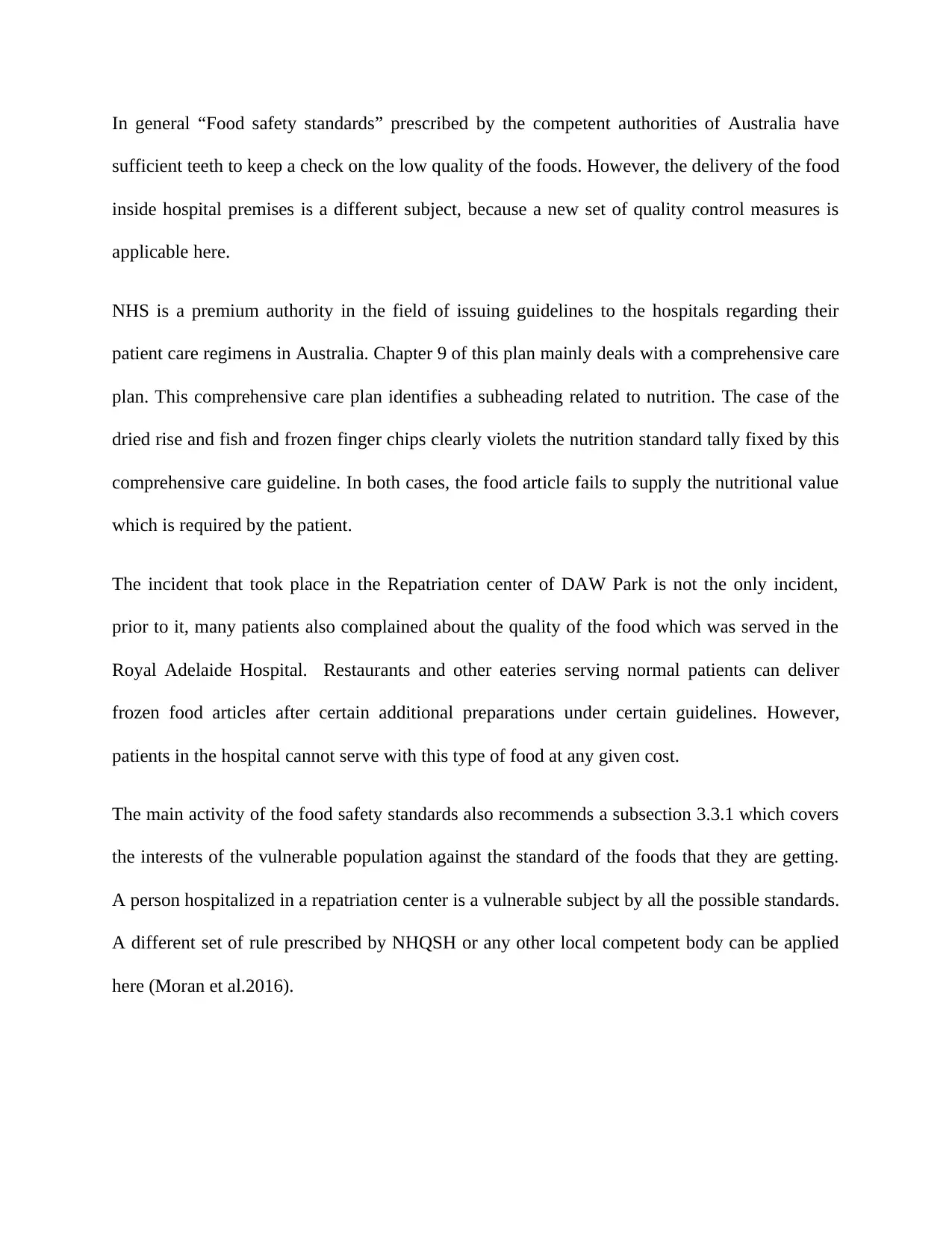
In general “Food safety standards” prescribed by the competent authorities of Australia have
sufficient teeth to keep a check on the low quality of the foods. However, the delivery of the food
inside hospital premises is a different subject, because a new set of quality control measures is
applicable here.
NHS is a premium authority in the field of issuing guidelines to the hospitals regarding their
patient care regimens in Australia. Chapter 9 of this plan mainly deals with a comprehensive care
plan. This comprehensive care plan identifies a subheading related to nutrition. The case of the
dried rise and fish and frozen finger chips clearly violets the nutrition standard tally fixed by this
comprehensive care guideline. In both cases, the food article fails to supply the nutritional value
which is required by the patient.
The incident that took place in the Repatriation center of DAW Park is not the only incident,
prior to it, many patients also complained about the quality of the food which was served in the
Royal Adelaide Hospital. Restaurants and other eateries serving normal patients can deliver
frozen food articles after certain additional preparations under certain guidelines. However,
patients in the hospital cannot serve with this type of food at any given cost.
The main activity of the food safety standards also recommends a subsection 3.3.1 which covers
the interests of the vulnerable population against the standard of the foods that they are getting.
A person hospitalized in a repatriation center is a vulnerable subject by all the possible standards.
A different set of rule prescribed by NHQSH or any other local competent body can be applied
here (Moran et al.2016).
sufficient teeth to keep a check on the low quality of the foods. However, the delivery of the food
inside hospital premises is a different subject, because a new set of quality control measures is
applicable here.
NHS is a premium authority in the field of issuing guidelines to the hospitals regarding their
patient care regimens in Australia. Chapter 9 of this plan mainly deals with a comprehensive care
plan. This comprehensive care plan identifies a subheading related to nutrition. The case of the
dried rise and fish and frozen finger chips clearly violets the nutrition standard tally fixed by this
comprehensive care guideline. In both cases, the food article fails to supply the nutritional value
which is required by the patient.
The incident that took place in the Repatriation center of DAW Park is not the only incident,
prior to it, many patients also complained about the quality of the food which was served in the
Royal Adelaide Hospital. Restaurants and other eateries serving normal patients can deliver
frozen food articles after certain additional preparations under certain guidelines. However,
patients in the hospital cannot serve with this type of food at any given cost.
The main activity of the food safety standards also recommends a subsection 3.3.1 which covers
the interests of the vulnerable population against the standard of the foods that they are getting.
A person hospitalized in a repatriation center is a vulnerable subject by all the possible standards.
A different set of rule prescribed by NHQSH or any other local competent body can be applied
here (Moran et al.2016).
⊘ This is a preview!⊘
Do you want full access?
Subscribe today to unlock all pages.

Trusted by 1+ million students worldwide
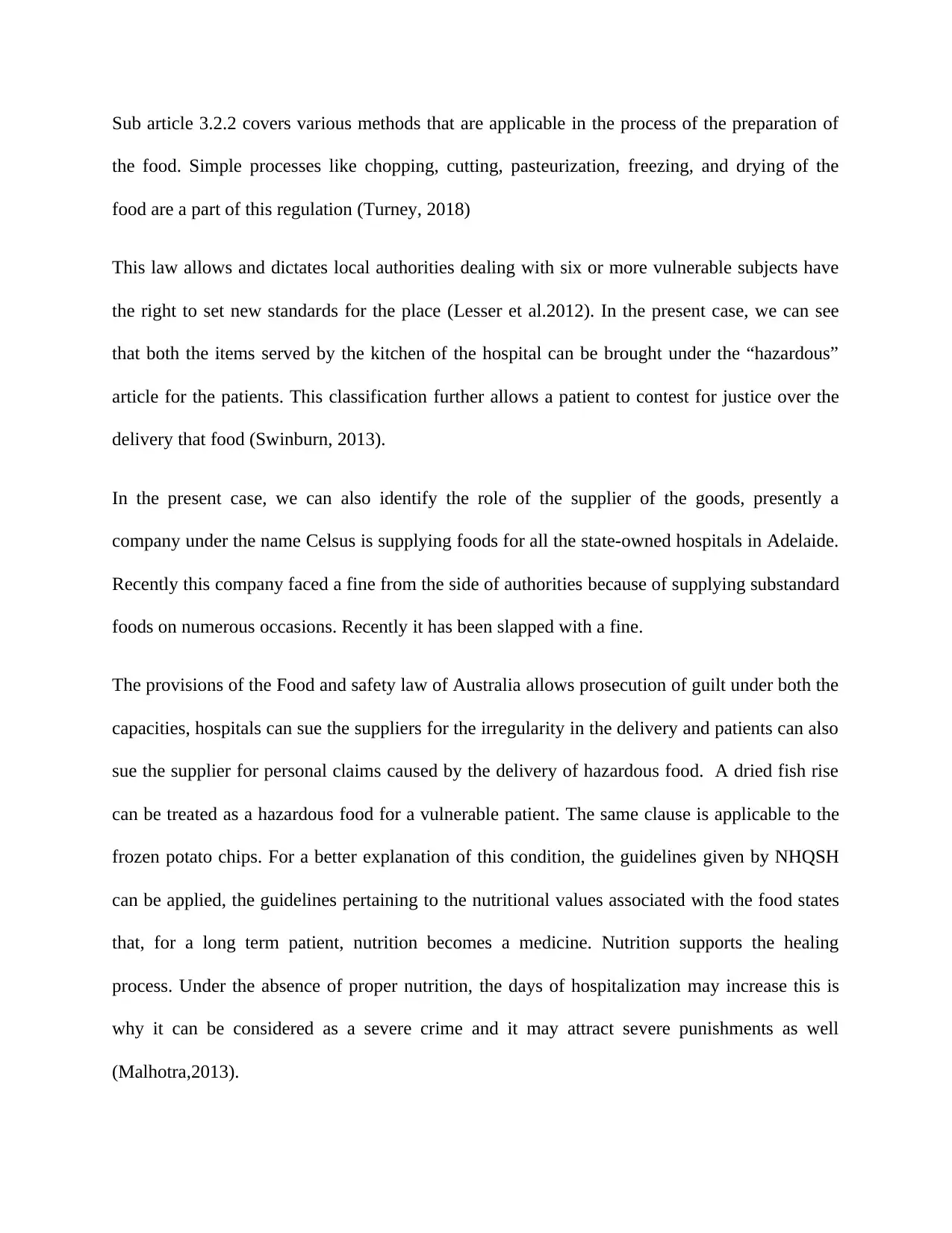
Sub article 3.2.2 covers various methods that are applicable in the process of the preparation of
the food. Simple processes like chopping, cutting, pasteurization, freezing, and drying of the
food are a part of this regulation (Turney, 2018)
This law allows and dictates local authorities dealing with six or more vulnerable subjects have
the right to set new standards for the place (Lesser et al.2012). In the present case, we can see
that both the items served by the kitchen of the hospital can be brought under the “hazardous”
article for the patients. This classification further allows a patient to contest for justice over the
delivery that food (Swinburn, 2013).
In the present case, we can also identify the role of the supplier of the goods, presently a
company under the name Celsus is supplying foods for all the state-owned hospitals in Adelaide.
Recently this company faced a fine from the side of authorities because of supplying substandard
foods on numerous occasions. Recently it has been slapped with a fine.
The provisions of the Food and safety law of Australia allows prosecution of guilt under both the
capacities, hospitals can sue the suppliers for the irregularity in the delivery and patients can also
sue the supplier for personal claims caused by the delivery of hazardous food. A dried fish rise
can be treated as a hazardous food for a vulnerable patient. The same clause is applicable to the
frozen potato chips. For a better explanation of this condition, the guidelines given by NHQSH
can be applied, the guidelines pertaining to the nutritional values associated with the food states
that, for a long term patient, nutrition becomes a medicine. Nutrition supports the healing
process. Under the absence of proper nutrition, the days of hospitalization may increase this is
why it can be considered as a severe crime and it may attract severe punishments as well
(Malhotra,2013).
the food. Simple processes like chopping, cutting, pasteurization, freezing, and drying of the
food are a part of this regulation (Turney, 2018)
This law allows and dictates local authorities dealing with six or more vulnerable subjects have
the right to set new standards for the place (Lesser et al.2012). In the present case, we can see
that both the items served by the kitchen of the hospital can be brought under the “hazardous”
article for the patients. This classification further allows a patient to contest for justice over the
delivery that food (Swinburn, 2013).
In the present case, we can also identify the role of the supplier of the goods, presently a
company under the name Celsus is supplying foods for all the state-owned hospitals in Adelaide.
Recently this company faced a fine from the side of authorities because of supplying substandard
foods on numerous occasions. Recently it has been slapped with a fine.
The provisions of the Food and safety law of Australia allows prosecution of guilt under both the
capacities, hospitals can sue the suppliers for the irregularity in the delivery and patients can also
sue the supplier for personal claims caused by the delivery of hazardous food. A dried fish rise
can be treated as a hazardous food for a vulnerable patient. The same clause is applicable to the
frozen potato chips. For a better explanation of this condition, the guidelines given by NHQSH
can be applied, the guidelines pertaining to the nutritional values associated with the food states
that, for a long term patient, nutrition becomes a medicine. Nutrition supports the healing
process. Under the absence of proper nutrition, the days of hospitalization may increase this is
why it can be considered as a severe crime and it may attract severe punishments as well
(Malhotra,2013).
Paraphrase This Document
Need a fresh take? Get an instant paraphrase of this document with our AI Paraphraser
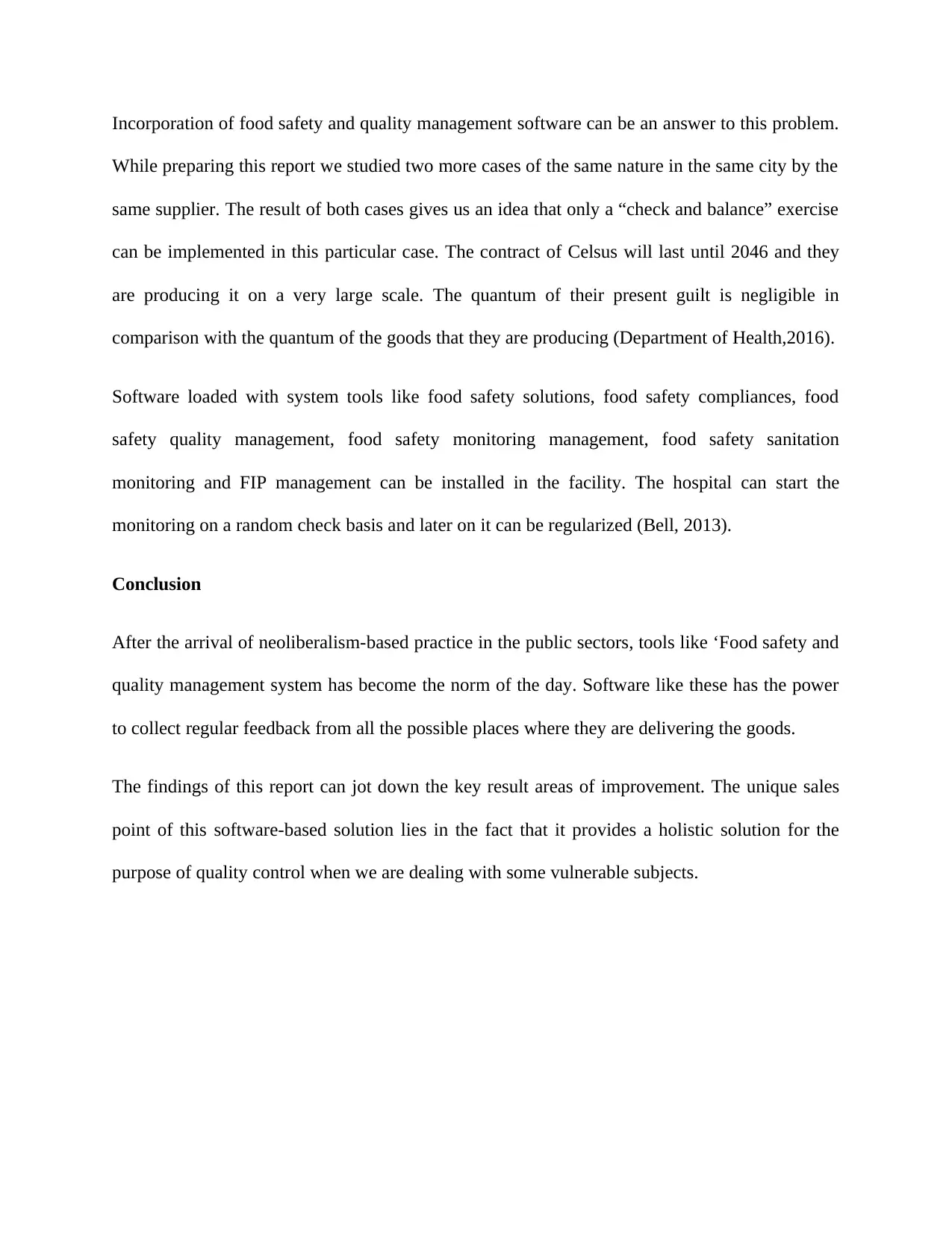
Incorporation of food safety and quality management software can be an answer to this problem.
While preparing this report we studied two more cases of the same nature in the same city by the
same supplier. The result of both cases gives us an idea that only a “check and balance” exercise
can be implemented in this particular case. The contract of Celsus will last until 2046 and they
are producing it on a very large scale. The quantum of their present guilt is negligible in
comparison with the quantum of the goods that they are producing (Department of Health,2016).
Software loaded with system tools like food safety solutions, food safety compliances, food
safety quality management, food safety monitoring management, food safety sanitation
monitoring and FIP management can be installed in the facility. The hospital can start the
monitoring on a random check basis and later on it can be regularized (Bell, 2013).
Conclusion
After the arrival of neoliberalism-based practice in the public sectors, tools like ‘Food safety and
quality management system has become the norm of the day. Software like these has the power
to collect regular feedback from all the possible places where they are delivering the goods.
The findings of this report can jot down the key result areas of improvement. The unique sales
point of this software-based solution lies in the fact that it provides a holistic solution for the
purpose of quality control when we are dealing with some vulnerable subjects.
While preparing this report we studied two more cases of the same nature in the same city by the
same supplier. The result of both cases gives us an idea that only a “check and balance” exercise
can be implemented in this particular case. The contract of Celsus will last until 2046 and they
are producing it on a very large scale. The quantum of their present guilt is negligible in
comparison with the quantum of the goods that they are producing (Department of Health,2016).
Software loaded with system tools like food safety solutions, food safety compliances, food
safety quality management, food safety monitoring management, food safety sanitation
monitoring and FIP management can be installed in the facility. The hospital can start the
monitoring on a random check basis and later on it can be regularized (Bell, 2013).
Conclusion
After the arrival of neoliberalism-based practice in the public sectors, tools like ‘Food safety and
quality management system has become the norm of the day. Software like these has the power
to collect regular feedback from all the possible places where they are delivering the goods.
The findings of this report can jot down the key result areas of improvement. The unique sales
point of this software-based solution lies in the fact that it provides a holistic solution for the
purpose of quality control when we are dealing with some vulnerable subjects.
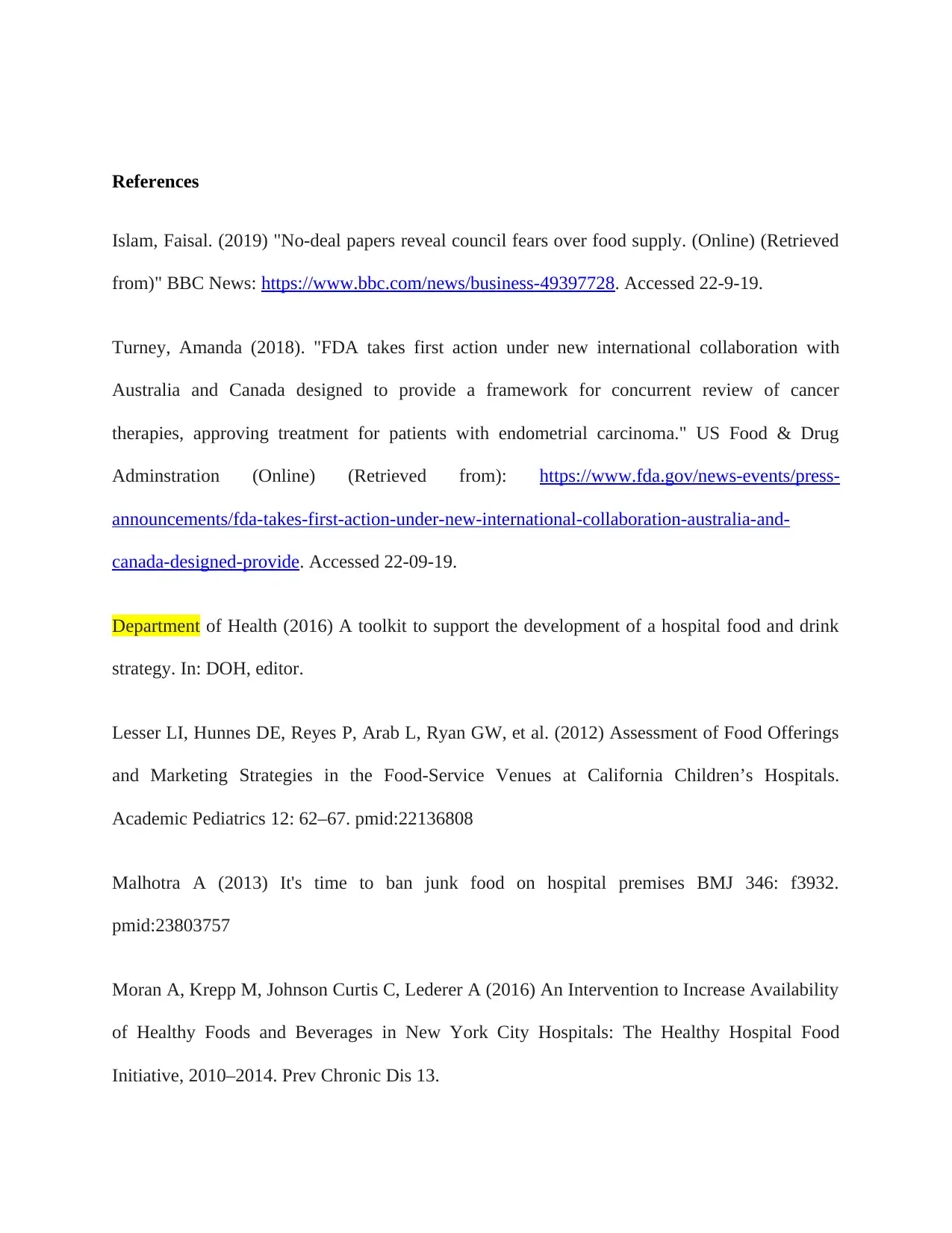
References
Islam, Faisal. (2019) "No-deal papers reveal council fears over food supply. (Online) (Retrieved
from)" BBC News: https://www.bbc.com/news/business-49397728. Accessed 22-9-19.
Turney, Amanda (2018). "FDA takes first action under new international collaboration with
Australia and Canada designed to provide a framework for concurrent review of cancer
therapies, approving treatment for patients with endometrial carcinoma." US Food & Drug
Adminstration (Online) (Retrieved from): https://www.fda.gov/news-events/press-
announcements/fda-takes-first-action-under-new-international-collaboration-australia-and-
canada-designed-provide. Accessed 22-09-19.
Department of Health (2016) A toolkit to support the development of a hospital food and drink
strategy. In: DOH, editor.
Lesser LI, Hunnes DE, Reyes P, Arab L, Ryan GW, et al. (2012) Assessment of Food Offerings
and Marketing Strategies in the Food-Service Venues at California Children’s Hospitals.
Academic Pediatrics 12: 62–67. pmid:22136808
Malhotra A (2013) It's time to ban junk food on hospital premises BMJ 346: f3932.
pmid:23803757
Moran A, Krepp M, Johnson Curtis C, Lederer A (2016) An Intervention to Increase Availability
of Healthy Foods and Beverages in New York City Hospitals: The Healthy Hospital Food
Initiative, 2010–2014. Prev Chronic Dis 13.
Islam, Faisal. (2019) "No-deal papers reveal council fears over food supply. (Online) (Retrieved
from)" BBC News: https://www.bbc.com/news/business-49397728. Accessed 22-9-19.
Turney, Amanda (2018). "FDA takes first action under new international collaboration with
Australia and Canada designed to provide a framework for concurrent review of cancer
therapies, approving treatment for patients with endometrial carcinoma." US Food & Drug
Adminstration (Online) (Retrieved from): https://www.fda.gov/news-events/press-
announcements/fda-takes-first-action-under-new-international-collaboration-australia-and-
canada-designed-provide. Accessed 22-09-19.
Department of Health (2016) A toolkit to support the development of a hospital food and drink
strategy. In: DOH, editor.
Lesser LI, Hunnes DE, Reyes P, Arab L, Ryan GW, et al. (2012) Assessment of Food Offerings
and Marketing Strategies in the Food-Service Venues at California Children’s Hospitals.
Academic Pediatrics 12: 62–67. pmid:22136808
Malhotra A (2013) It's time to ban junk food on hospital premises BMJ 346: f3932.
pmid:23803757
Moran A, Krepp M, Johnson Curtis C, Lederer A (2016) An Intervention to Increase Availability
of Healthy Foods and Beverages in New York City Hospitals: The Healthy Hospital Food
Initiative, 2010–2014. Prev Chronic Dis 13.
⊘ This is a preview!⊘
Do you want full access?
Subscribe today to unlock all pages.

Trusted by 1+ million students worldwide
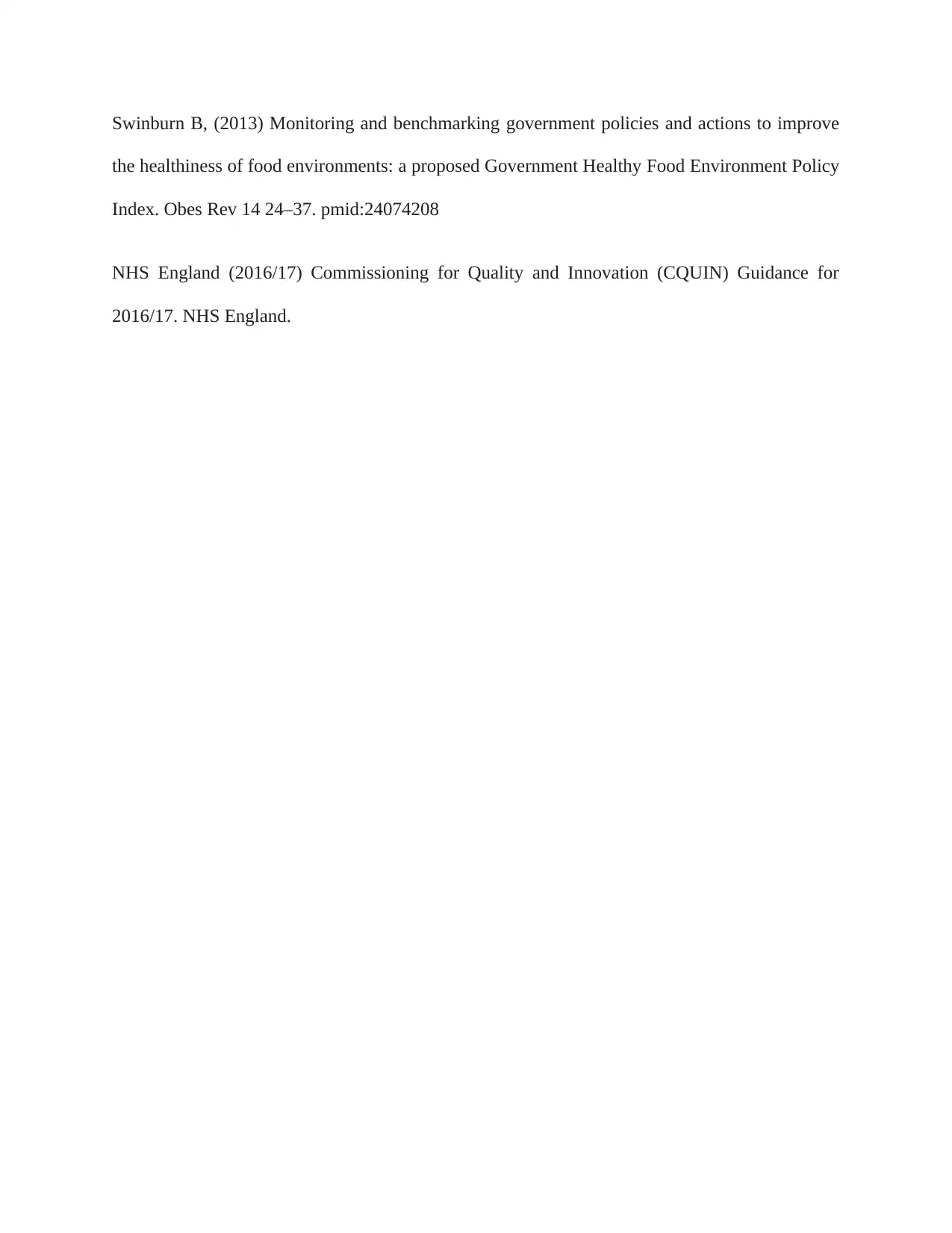
Swinburn B, (2013) Monitoring and benchmarking government policies and actions to improve
the healthiness of food environments: a proposed Government Healthy Food Environment Policy
Index. Obes Rev 14 24–37. pmid:24074208
NHS England (2016/17) Commissioning for Quality and Innovation (CQUIN) Guidance for
2016/17. NHS England.
the healthiness of food environments: a proposed Government Healthy Food Environment Policy
Index. Obes Rev 14 24–37. pmid:24074208
NHS England (2016/17) Commissioning for Quality and Innovation (CQUIN) Guidance for
2016/17. NHS England.
1 out of 7
Your All-in-One AI-Powered Toolkit for Academic Success.
+13062052269
info@desklib.com
Available 24*7 on WhatsApp / Email
![[object Object]](/_next/static/media/star-bottom.7253800d.svg)
Unlock your academic potential
Copyright © 2020–2025 A2Z Services. All Rights Reserved. Developed and managed by ZUCOL.